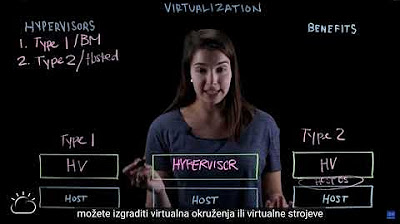Virtual machines
Summary
TLDRVirtualization technology allows multiple virtual machines (VMs) to run on a single physical server, sharing resources like CPU, storage, and networking. Google Cloud’s Compute Engine provides scalable virtual machines with flexible configuration, billing by the second, and discounts for sustained or committed usage. Users can create VMs via the Cloud Console, CLI, or API, and select from predefined or custom machine types. Cost-saving options include Preemptible and Spot VMs for non-critical workloads, offering savings up to 90%. Compute Engine allows businesses to optimize resource usage while maintaining high performance and flexibility.
Takeaways
- 💻 Virtualization technology allows multiple systems, known as virtual machines (VMs), to run on the same hardware for efficient resource utilization.
- ☁️ Google Cloud’s Compute Engine is an Infrastructure-as-a-Service (IaaS) product that enables users to create and run VMs on Google’s global infrastructure.
- ⚙️ Each virtual machine operates like a full-fledged computer, with configurable CPU power, memory, storage, and operating system options.
- 🧠 VMs share the same pool of processing, storage, and networking resources, optimizing performance and flexibility.
- 🖥️ Compute Engine instances can be created and managed via the Google Cloud Console, the Cloud CLI, Terraform, or the Compute Engine API.
- 🔗 An API (Application Programming Interface) allows different software systems to communicate and automate interactions with Compute Engine resources.
- 💰 Compute Engine uses per-second billing with a one-minute minimum, and sustained-use discounts automatically apply the longer a VM runs.
- 📉 Committed-use discounts provide cost savings for users who commit to using resources for 1-year or 3-year periods.
- ⚡ Preemptible and Spot VMs offer up to 90% cost reductions for non-critical, interruptible workloads like batch data analysis.
- 🕒 Spot VMs have no maximum runtime and provide more flexibility than Preemptible VMs, though both have similar pricing.
- 🧩 Users can choose from predefined machine types or create custom configurations to tailor VM performance and cost to specific needs.
Q & A
What problem did virtualization technology help solve for organizations?
-Virtualization relieved the pressure of binding specific computing hardware resources to specific applications, allowing for more flexible and efficient use of hardware.
What is virtualization in computing?
-Virtualization is a form of resource optimization that enables multiple systems, called virtual machines (VMs), to run on the same physical hardware by sharing processing, storage, and networking resources.
What are virtual machines (VMs)?
-Virtual machines are software-based systems that emulate physical computers, allowing multiple operating systems and applications to run independently on the same hardware.
What is Google Compute Engine?
-Google Compute Engine is Google Cloud's Infrastructure-as-a-Service (IaaS) product that allows users to create and run virtual machines on Google’s infrastructure without upfront investments.
How are Compute Engine virtual machines billed?
-Compute Engine bills VMs by the second with a one-minute minimum. Sustained-use discounts automatically apply when a VM runs for more than 25% of a month, offering additional savings the longer the VM runs.
What are committed-use discounts in Compute Engine?
-Committed-use discounts are reduced prices offered when users commit to using specific resources for a fixed term, typically one or three years, compared to on-demand pricing.
What are Preemptible and Spot VMs?
-Preemptible and Spot VMs are cost-effective instances designed for workloads that can be interrupted. They can be up to 90% cheaper than regular VMs but may be stopped by Google to reclaim capacity.
How do Spot VMs differ from Preemptible VMs?
-While both can be interrupted by Google, Spot VMs have no maximum runtime limit and offer more features than Preemptible VMs, which can run for a maximum of 24 hours.
How can users create virtual machine instances in Google Compute Engine?
-Users can create VM instances through the Google Cloud Console (a web-based tool), the Google Cloud CLI, infrastructure automation tools like Terraform, or directly via the Compute Engine API.
What is an API in the context of Google Compute Engine?
-An API, or Application Programming Interface, is a set of instructions that enables different software programs to communicate with each other and automate interactions with services like Compute Engine.
What customization options are available when configuring a Compute Engine virtual machine?
-Users can specify the number of virtual CPUs, amount of memory, type and amount of storage, operating system, and can choose from predefined machine types or create custom machine types.
Why are Preemptible or Spot VMs ideal for batch processing workloads?
-They are suitable because such jobs don’t require human supervision and can tolerate interruptions, making it cost-effective to use these lower-priced, preemptible resources.
Outlines

Этот раздел доступен только подписчикам платных тарифов. Пожалуйста, перейдите на платный тариф для доступа.
Перейти на платный тарифMindmap

Этот раздел доступен только подписчикам платных тарифов. Пожалуйста, перейдите на платный тариф для доступа.
Перейти на платный тарифKeywords

Этот раздел доступен только подписчикам платных тарифов. Пожалуйста, перейдите на платный тариф для доступа.
Перейти на платный тарифHighlights

Этот раздел доступен только подписчикам платных тарифов. Пожалуйста, перейдите на платный тариф для доступа.
Перейти на платный тарифTranscripts

Этот раздел доступен только подписчикам платных тарифов. Пожалуйста, перейдите на платный тариф для доступа.
Перейти на платный тариф5.0 / 5 (0 votes)






